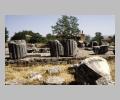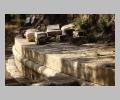| Summary: | One of the oldest and most powerful cities of Arkadia. |
| Type: | Fortified city |
| Region: | Arcadia |
Periods:
Geometric
Archaic
Classical
Hellenistic
Roman
Byzantine
Physical:
Ancient Tegea, ca 10 km SE of modern Tripolis, extended over a large area on an upland plain that had previously been occupied by 9 smaller villages. It had a city wall from ca. 370 B.C. and, in addition to the agora, theater, stadium and other civic buildings, it was the location of a Sanctuary of Demeter and Kore where many Geometric and Archaic votives have been excavated.
The main sanctuary of ancient Tegea, however, was the Temple of Athena Alea, reputed in ancient times as one of the most important religious centers in Greece. The sanctuary originated in the Geometric period and served throughout antiquity as a famous place of asylum for fugitives and exiles, including a number of former kings of Sparta. The Archaic Temple of Athena was replaced by a new temple in the 4th century B.C. and in the 5th century A.D. a Christian church was built in its cella.
Description:
Tegea, one of the oldest cities of Arkadia, was first recorded in the Homeric Catalogue of Ships. In the Archaic period the 9 villages of Tegea joined in a synoicism to form one large city (cf. Mantinea and Sparta). After a long period of struggle, Tegea was forced into the role of a vassal state by Sparta at ca. 560 B.C. It remained under Spartan control until it joined the Arkadian League and fought against Sparta in 362 B.C. At ca. 370 B.C. Tegea constructed its first city walls. During the 3rd century, however, Tegea suffered 3 defeats by the Spartans.
In 222 B.C. Tegea was forced into the Achaean League and it continued to lose political power during the Hellenistic period. The city retained its prosperity and commercial importance, however, and flourished well into the Roman period. At ca. A.D. 395 Tegea was destroyed by the Goths, but was rebuilt under the name Nikli, and became one of the most important Byzantine cities in the Peloponnese.
Exploration:
G. Fougeres and V. Bérard excavated in 1888-1889 for the French School. The Temple of Alea Athena was investigated by A. Milchhöfer in 1879 and by W. Dörpfeld in 1882: it was excavated by G. Mendel and C. Dugas of the French School between 1900 and 1910. K. Dimakopoulou excavated at the site in 1964-1965. The current excavations (1990-) are conducted by the Norwegian Institute at Athens, under the direction of E. Oestby.<
Sources Used:
Other Bibliography:





